
- •The Vikings
- •Part I
- •Professor Kenneth W. Harl
- •Kenneth W. Harl, Ph.D.
- •Table of Contents
- •The Vikings
- •Part I
- •The Vikings
- •Lecture One
- •The Vikings in Medieval History
- •Outline
- •Lecture Two
- •Land and People of Medieval Scandinavia
- •Outline
- •Lecture Three
- •Scandinavian Society in the Bronze Age
- •Outline
- •Lecture Four
- •Scandinavia in the Celtic and Roman Ages
- •Outline
- •Lecture Five
- •The Age of Migrations
- •Outline
- •Lecture Six
- •The Norse Gods
- •Outline
- •Lecture Seven
- •Runes, Poetry, and Visual Arts
- •Outline
- •Lecture Eight
- •Legendary Kings and Heroes
- •Outline
- •Lecture Nine
- •A Revolution in Shipbuilding
- •Outline
- •Lecture Ten
- •Warfare and Society in the Viking Age
- •Outline
- •Lecture Eleven
- •Merchants and Commerce in the Viking Age
- •Outline
- •Lecture Twelve
- •Christendom on the Eve of the Viking Age
- •Outline
- •Timeline
- •Maps
- •The Vikings
- •Part II
- •Professor Kenneth W. Harl
- •The Teaching Company ®
- •Kenneth W. Harl, Ph.D.
- •Table of Contents
- •The Vikings
- •Part II
- •The Vikings
- •Lecture Thirteen
- •Viking Raids on the Carolingian Empire
- •Outline
- •Lecture Fourteen
- •The Duchy of Normandy
- •Outline
- •Lecture Fifteen
- •Viking Assault on England
- •Outline
- •Lecture Sixteen
- •The Danelaw
- •Outline
- •Lecture Seventeen
- •Viking Assault on Ireland
- •Outline
- •Lecture Eighteen
- •Norse Kings of Dublin and Ireland
- •Outline
- •Lecture Nineteen
- •The Settlement of Iceland
- •Outline
- •Lecture Twenty
- •Iceland—A Frontier Republic
- •Outline
- •Lecture Twenty-One
- •Skaldic Poetry and Sagas
- •Outline
- •Lecture Twenty-Two
- •Western Voyages to Greenland and Vinland
- •Outline
- •Lecture Twenty-Three
- •Swedes in the Baltic Sea and Russia
- •Outline
- •Lecture Twenty-Four
- •The Road to Byzantium
- •Outline
- •Maps
- •Biographical Notes
- •The Vikings
- •Part III
- •Professor Kenneth W. Harl
- •The Teaching Company ®
- •Kenneth W. Harl, Ph.D.
- •Table of Contents
- •The Vikings
- •Part III
- •The Vikings
- •Lecture Twenty-Five
- •From Varangians into Russians
- •Outline
- •Lecture Twenty-Six
- •Transformation of Scandinavian Society
- •Outline
- •Lecture Twenty-Seven
- •St. Anskar and the First Christian Missions
- •Outline
- •Lecture Twenty-Eight
- •Formation of the Kingdom of Denmark
- •Outline
- •Lecture Twenty-Nine
- •Cnut the Great
- •Outline
- •Lecture Thirty
- •Collapse of Cnut’s Empire
- •Outline
- •Lecture Thirty-One
- •Jarls and Sea Kings of Norway
- •Outline
- •Lecture Thirty-Two
- •St. Olaf of Norway
- •Outline
- •Lecture Thirty-Three
- •Kings of the Swedes and Goths
- •Outline
- •Lecture Thirty-Four
- •Christianization and Economic Change
- •Outline
- •Lecture Thirty-Five
- •From Vikings to Crusaders
- •Outline
- •Lecture Thirty-Six
- •The Viking Legacy
- •Outline
- •Maps
- •Glossary
- •Bibliography
Lecture Thirty-Six
The Viking Legacy
Scope: The course of medieval history was fundamentally altered by the Viking Age (790–1100), but ironically, the common experience of the Viking Age led to a united Scandinavia in the later Middle Ages. Danish and Norwegian Vikings revealed the institutional weaknesses of the Carolingian Empire. As a consequence, the feudal states of Western Europe were born in the Viking assaults of the 9th and 10th centuries. The kingdoms of England and Scotland likewise arose in the British Isles. Orthodox Kiev, founded by Swedish Rus, gave political organization to the East Slavic peoples and forever linked them to the Byzantine commonwealth. The three Scandinavian kingdoms also emerged out of the Viking experience, as did the Norse settlements in the North Atlantic. In poetry, saga, decorative arts, and shipbuilding, Scandinavians of the Viking Age made major contributions. To be sure, the Vikings are still remembered foremost as worshiping the terrifying and ancient Germanic gods, pillaging monasteries, and enslaving Christians. The Vikings, more than any other invaders, struck fear into the hearts of Christians, who implored God to spare them from the fury of the Northmen. In so doing, the Vikings gave Christian Europe strength, and thus, the era of the Crusades would have been impossible without the era of the Vikings.
Outline
I.We shall conclude the course by looking at what would become of the Scandinavian nations as Christian kingdoms that had been integrated into the wider European world. We shall also sum up the importance of the Viking Age for Scandinavia and for medieval civilization as a whole.
II.What was the future for Scandinavia in the aftermath of the Viking Age?
A.We have looked at the history of Scandinavia up until the year 1350, which was the time of the Black Death. This great epidemic raged across Europe and the Near East between 1347–1351, killing between one-half and two-thirds of the population.
1.The attrition rates in cities from the Black Death were nothing short of catastrophic. Figures from the Mediterranean world suggest that within two months of the plague’s arrival, a city could lose 75–80 percent of its population. The plague had major repercussions in economic, political, and religious life for both Christian and Islamic civilizations, and Scandinavia was profoundly affected by it, notably Norway and Denmark.
2.The aftermath of the Black Death, along with the rising prosperity in Scandinavia, the common Viking heritage and culture, and the success achieved in forging territorial Christian kingdoms, combined to unite the three kingdoms of Scandinavia for a brief period starting in 1397.
B.The Union of Kalmar saw the unification of Norway, Denmark, and Sweden in the hands of Erik of Pomerania (r. 1389–1442), the great-nephew of Queen Margaret of Denmark (r. 1389–1439), who was the daughter of Valdemar IV of Denmark.
C.The unification seemed to promise a new age for Scandinavia. An effective Scandinavian monarchy could curb the power of the Hanseatic League, which had come to dominate banking and shipping, and could enable Scandinavia to compete with the other monarchies emerging in the late medieval period, particularly England, France, and Poland and the principalities of Germany.
D.Unfortunately, the unification did not fulfill its promise. The Union of Kalmar was brought about more by weakness and hope than strength; from the start, the Swedes turned the union to their own advantage and restricted royal rights in Sweden. The Union of Kalmar also revealed several important characteristics of the development of Scandinavian society.
1.Danes, Norwegians, and Swedes had evolved into different peoples. They were no longer speakers of a common language. In their mores and aesthetics, the Danes resembled their German neighbors to the south.
2.Norway was treated as an unimportant outland province by the Danes. Both Norway and Denmark had been hit hard by the Black Death, but Denmark recovered rapidly. Immigration from Germany helped to replenish the population of Denmark, and the economic consequences of the epidemic favored trade
©2005 The Teaching Company Limited Partnership |
35 |
in “luxury” over subsistence goods. In Norway, the economy depended on the export of bulk goods, such as cod, for which there was no market; in contrast, Denmark’s economy was based in part on dairy products and meat, which were more in demand from the smaller remaining populations of Europe.
3.Norway was integrated into the Danish kingdom because its population had been so decimated by the Black Death that it no longer had sufficient numbers of bishops and leading landowners to carry on royal institutions. The Danish crown, under the Union of Kalmar, appointed Danish and German officials to run Norway and transform it into a Danish province.
E.Sweden was affected the least by the demographic and economic implications of the Black Death and did quite well in the 14th and 15th centuries. Eventually, the Royal Council in Sweden was able to assert itself and shake off Danish rule.
F.The result of the Union of Kalmar was the reconfiguration of two kingdoms, Norway-Denmark under the Oldenburg dynasty and Sweden-Finland under the Vasa dynasty, which would both become hereditary monarchies and would vastly expand their powers during the Reformation. These two monarchies represented quite separate national identities. The kings of Denmark and the kings of Sweden would go on to struggle for mastery in the Baltic, but in the end, Moscow would win.
III.Our course has been more ambitious than its title implies: We have not looked just at the Viking Age but at the evolution of Scandinavia before the Viking Age and in the centuries immediately after. This wider perspective is important for understanding the decisive role played by the Scandinavians in the Viking Age.
A.In the first third of the lectures, we looked at the origins of Scandinavian civilization, the influence of Western and Central Europe on that civilization, and the Scandinavians’ ability to assimilate technological and cultural innovations of other nations into their landscape.
1.We started in the Bronze Age, during which the adoption of farming and stock-raising techniques, as well as bronze tools, led to the birth of the first significant Scandinavian cultural period, the Northern Bronze Age (1550–1100 B.C.). In this period, the core areas of Scandinavia were settled, the practice of agriculture was begun, and the Scandinavian gods were defined.
2.This pattern was repeated in the Celtic and Roman Ages, when trade and immigration greatly enriched the material life of Scandinavians and led to technological changes in shipbuilding, starting around 300.
3.The trade connections with Western Europe that developed in the Celtic and Roman Ages continued in the Age of Migrations (400–600 A.D.). This period was decisive in shaping the civilization of the Viking Age; at this time, the Scandinavians lived by their martial ethos and had defined themselves as distinct from their Germanic kinsmen. The “Danish tongue” was developed, as was Scandinavian poetry, which in turn, intensified the heroic traditions of the Vikings.
B.We devoted almost a third of this course to the Viking impact overseas during the Viking Age, and we might reflect on how wide-ranging the Scandinavians’ influence was: Viking trade, raiding, and settlement wrought great changes from Ireland to Russia.
1.Vikings were feared by Christians and Muslims as the quintessential barbarians. The stereotypical images that we still have of the Vikings can be traced back to the images of the 9th and 10th centuries, and as we have learned, these images have some basis in history.
2.The Vikings revealed the fundamental fiscal and military weaknesses in the Carolingian Empire. In place of that empire, Europe broke up into smaller states that became the building blocks for the new European political order that would emerge.
3.Indeed, the Vikings established the premier feudal state in this new order, the duchy of Normandy. It is inconceivable to imagine European history without Normandy and the Normans. They forged the most effective state in what was to become France; William the Conqueror took England and reintegrated the British Isles into the political order of Western Europe; and the Normans founded the Kingdom of the Two Sicilies in southern Italy, destined to become one of the great four monarchies of the Middle Ages.
4.The Vikings also dictated the course of English history. In response to the Danish attacks, one of the most brilliant kings of the early Middle Ages, Alfred the Great, forged the institutions that allowed his descendants to incorporate the inhabitants of the Danelaw into an expanded and unified kingdom.
36 |
©2005 The Teaching Company Limited Partnership |
5.Viking attacks in Ireland destroyed the brilliant monastic culture of the early Middle Ages and, in many ways, determined the future course of Irish history. In the wake of the Viking Age, Ireland was condemned to political fragmentation until the arrival of the Normans in 1170.
6.Scotland, too, was a creation of the Viking Age. The Scots took advantage of the political disorder
caused by the Viking raids to unite the northern third of Britain into the Kingdom of Scotland in the late 10th century.
7.Finally, the Russian principalities owed their creation directly to the efforts of the Rus in developing market towns and trade with Constantinople. The civilization that emerged in the Russian forest zone was sparked by the activities of Scandinavians.
8.Therefore, the Vikings had a major impact in determining the religious, economic, and political destinies of Western and Eastern Europe.
C.Over the course of these lectures, we have also seen profound changes in Scandinavia, and we should consider some of the more positive contributions made by Scandinavians.
1.Scandinavians were largely responsible for the evolution of shipbuilding in the late 10th and 11th centuries, which climaxed with the development of the great longships and knarrs. In the early Middle Ages, the Scandinavians achieved a shipbuilding tradition in northern Europe parallel to that achieved in the ports of Italy, southern France, and eastern Spain.
2.Scandinavians were particularly adept at assimilating outside influences. For example, Cnut adapted the institutions of England to create an effective Danish state. Christianity triumphed in Scandinavia because it was accommodated to existing social and economic institutions; we saw this phenomenon particularly in Iceland.
3.The Scandinavians were also receptive to the technological advantages that accompanied the conversion to Christianity. Between 1100–1350, they rapidly took on superior techniques in agriculture and modified their laws and institutions to create a Christian Scandinavia.
D.In the end, what was the overall Viking impact on medieval civilization? Perhaps we can sum it up in two conclusions: First, despite the suffering and destruction wrought by the Vikings, their prowess in warfare forced Christian Europe to organize and arm itself—to become strong. Second, the intrepid settlers in Iceland, just below the Arctic Circle, recorded the ancient traditions of the Norse past and transmitted that literary heritage to Western Europe. Indeed, the greatest victories of the Vikings were not in England, not in Normandy, and not in Russia, but on the velums—the manuscripts—composed in Iceland.
Further Reading:
Peter Foote and David M. Wilson. The Viking Achievement: The Society and Culture of Early Medieval Scandinavia. London: Sidgwick and Jackson, 1970.
Rosedahl, Else. The Vikings. 2nd ed. Translated by S. M. Margeson and K. William. New York: Penguin Books, 1998.
Questions to Consider:
1.Why did the Scandinavians fail to achieve political unity in the later Middle Ages despite the common experience of the Viking Age? What was the purpose of the Union of Kalmar in 1397, and why did it fail?
2.How did the Vikings alter the course of medieval history? What was the nature of the Viking impact on the Carolingian Empire, England, Ireland, and Russia? How did Viking attacks, trade, and settlement transform these societies? How did the Viking Age transform Scandinavian life? Why did the Scandinavian monarchies owe their creation to the Viking Age? What were the greatest contributions of the Viking Age?
©2005 The Teaching Company Limited Partnership |
37 |
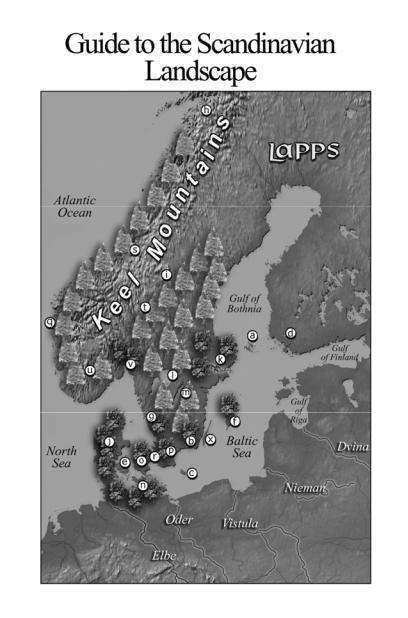
Maps
38 |
©2005 The Teaching Company Limited Partnership |
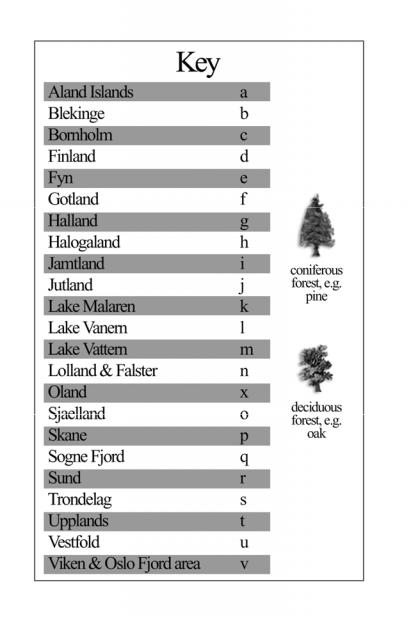
©2005 The Teaching Company Limited Partnership |
39 |
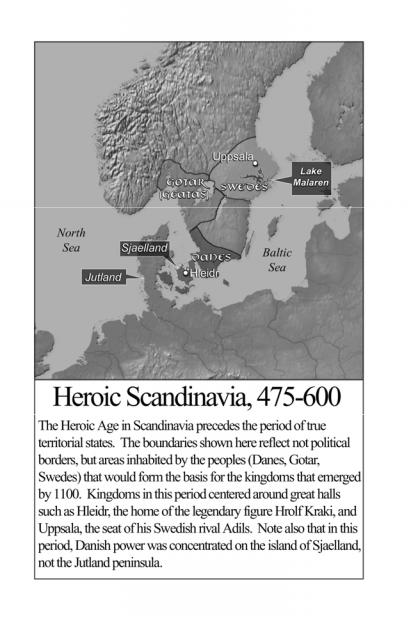
40 |
©2005 The Teaching Company Limited Partnership |

©2005 The Teaching Company Limited Partnership |
41 |
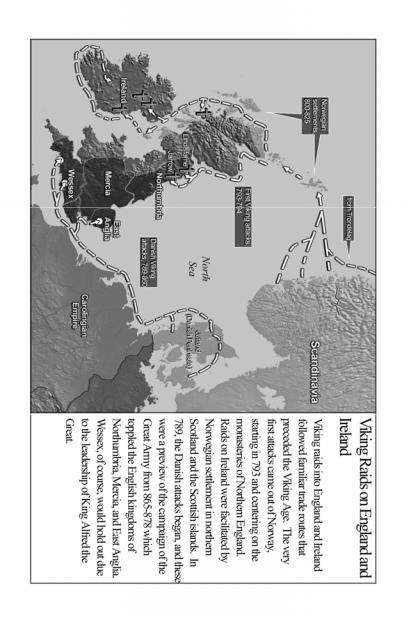
42 |
©2005 The Teaching Company Limited Partnership |
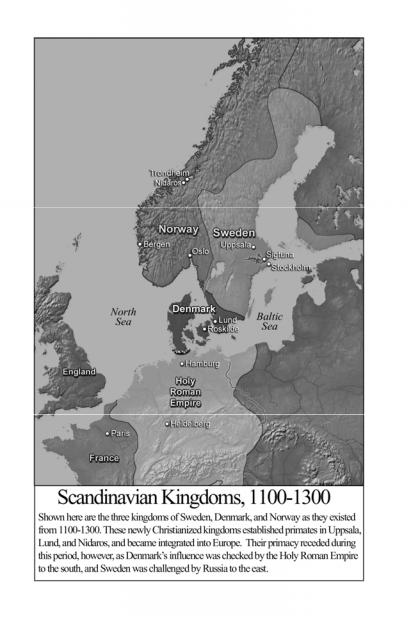
©2005 The Teaching Company Limited Partnership |
43 |
